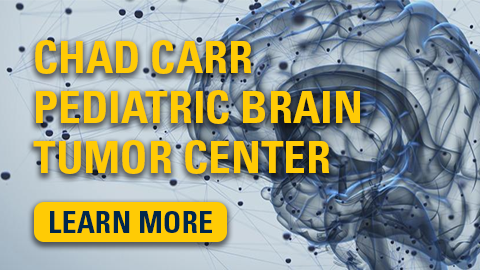Immune-suppressive myeloid cells in the glioma microenvironment: Signaling mechanisms and novel therapeutic strategies
Castro M, Lowenstein P, Muraszko K
NIH R37 NS 09480406
7/1/2019 – 6/30/2022
Glioblastoma multiforme (GBM) is the most common primary malignant brain tumor in adults; median survival from diagnosis is ~15-21 months. Anti-GBM immune strategies constitute novel and exciting therapeutic adjuvants to improve survival due to surgery, chemo-and radiotherapy. However, it has been challenging to develop effective anti-GBM immune responses that translate into increased patients' survival. As systemic immune responses against GBM antigens can be induced, clinical failure is thought to be due to powerful GBM induced immune suppression. Immune suppression in GBM patients is mediated by various mechanisms that include immature myeloid cells (IMCs) that accumulate in the tumor microenvironment. Subtypes of immature myeloid cells are: (i) myeloid derived suppressor cells (MDSCs), (ii) immunosuppressive tumor associated macrophages (TAMs), and, (iii) Tie2+ monocytes (TEMs). GBMs recruit immature myeloid cells to the tumor microenvironment where they inhibit anti-tumor immune responses, for example, by directly inhibiting T-cell effector function. Additional Immune suppressive mechanisms involve: accumulation of Tregs, immunosuppressive molecules (i.e., indoleamine2, 3-dioxygenase 1 (IDO), cytotoxic T-lymphocyte antigen 4 (CTLA4), and programmed death 1 receptor ligand (PDL1), and cytokines, (i.e., IL-10, TGFβ). To identify secreted factors which attract immune-suppressive IMCs into the GBM microenvironment we performed DNA microarray analysis on endogenous and transplantable mouse and human GBM cells and identified CXCL12 as a possible candidate. We also identified CXCR4, thecognate CXCL12 receptor, on immature myeloid cells within the GBM microenvironment supporting the hypothesis that CXCL12/CXCR4 plays an important role in attracting IMCs to the GBM microenvironment. To ascertain the role played by CXCL12-CXCR4 signaling in GBM progression and in regulating anti-GBM immune therapies, we propose to use an immune competent, genetically engineered endogenous mouse GBM model. Intracranial tumors are induced by Sleeping Beauty (SB)-mediated insertion of genetic alterations found in human GBM. Preliminary data show that conditioned media from both transplantable and SB-induced GBM elicit a high level of IMCs' expansion in vitro. In GBM models in vivo, we observed accumulation of IMCs within the GBM microenvironment and in the peripheral circulation. CXCR4 blockade significantly prolonged median survival of mice bearing endogenous GBM. We will use CXCL12 and/or CXCR4 gene ablation models to test the hypothesis that CXCL12-CXCR4 signaling axis plays a major role in determining the immune profile, both qualitatively and quantitatively, of the GBM microenvironment and thus has profound effects on disease progression. We further hypothesize that blocking accumulation of IMCs in combination with anti-GBM immune stimulatory strategies will provide a powerful adjuvant approach to treat malignant brain cancer.
Targeting glioblastoma stem cells through epigenetic reprogramming
Fan X, Muraszko K
NIH R01 NS 10661603
6/15/2018 – 3/31/2023
Glioblastoma (GBM) is the most common malignant brain tumor in adult with poor clinical outcome. There has been a lack of revolutionary improvement in treatment of this deadly disease over the past 40 years. Any treatment that can significantly prolong patients' overall survival for more than three months, which is the best achievement so far to treat GBM when using surgery, radiation therapy and temozolomide, can be considered as a success. Our long-term goal is to develop novel therapeutic strategies for this lethal disease. GBM cancer stem-like cells (CSCs) were recently prospectively isolated by several groups and showed resistance to conventional radiation therapy and chemotherapy. Targeting CSCs therapy brings a hope for brain tumor patients. The notch signaling is a developmental signaling pathway that has been found activated in GBM CSCs. We have demonstrated that notch inhibition deplete GBM CSCs and prolong survival in mice bearing intracranial GBM xenografts. A recent Phase I clinical trial study shows that a quarter of malignant glioma patients have stabilized disease for more than four month after notch inhibitor treatment. However, the targets that mediate notch regulated GBM CSC self-renewal are largely unknown. As CSCs give rise to non-CSC cells, the major difference between the two is a different level of gene expression regulated by epigenetics, such as DNA methylation and histone modification, including acetylation. Our preliminary data from microarray analysis on notch inhibitor treated GBM neurosphere showed that an epigenetic factor histone deacetylase 4 (DHAC4) is regulated by notch signaling. Furthermore, our preliminary studies showed that that HDAC4 is required for GBM neurosphere propagation in vitro and in vivo. In order to develop new targets to deplete GBM CSCs, the current proposal will examine the molecular mechanism by which notch regulates HDAC4 and its impact on GBM CSCs, and its translational application. In specific Aim 1, we will define the functional effect of different protein domains of HDAC4 on GBM CSCs. In specific Aim 2, we will define the role of notch and HDAC4 interaction on self-renewal of GBM CSCs. In specific Aim 3, we will examine a combination of notch and HDAC4 inhibition therapy in GBM patient-derived orthotopic xenografts (PDXs). Successes in the current proposal will not only discover how an epigenetic factor HDAC4 regulates self-renewal of GBM CSCs and improve GBM treatment, but also will have a clinical impact on cancer therapy in general.
Principal Investigator





